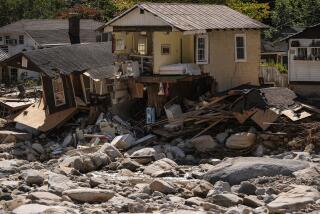TV was the eye on the storm
- Share via
On television, the Hurricane Katrina Story has played out in several phases. It constituted a weeklong true-life miniseries that completely took over several channels -- on CNN, Fox, CNBC and MSNBC, it was almost the only news there was -- and made itself heavily felt elsewhere, dominating network news to the near-exclusion of the rest of the world.
Ultimately the story was less about the disaster itself -- the wind, the water and later the fire -- than the failure to deal with it quickly, to protect the many citizens who found themselves marooned, bereft of food, water, medicine, protection or guidance. It was universally observed among newspeople that such a thing happening in the United States was incredible -- Third World was the operative term -- which suggests that they had not been paying much attention to the lot of the domestic poor. Many reporters questioned whether the lack of preparedness and poor follow-through had anything to do with the diversion of men, materiel and money to Iraq, but none I heard mentioned the American mania for tax cuts.
It began as a tale of implacable nature (invariably called “Mother Nature”), a disaster movie, and as in every disaster movie there was an initial disinclination to believe the worst. Then the worst came, followed by a false calm. And then, as New Orleans filled with water, the story rapidly converted into a post-apocalyptic thriller -- “The Day After Tomorrow” or “Escape from New York” -- which became a story of human inefficiency, error, folly and political misadventure: a John Sayles movie.
Then the cavalry came, in the form of a military convoy, and the tardy president followed soon after, dispensing hugs and platitudes -- sincerely, I do not doubt, though of course it was a political necessity as well. He talked of the “good folks,” who “gotta understand” that “this is a huge task” but that “the good news is that we’re gonna get things done,” and, in a brief news conference in a splintered Mississippi suburb, smirked nervously. (Any random interview with a person on the street produced more eloquent insight.) He gave a shout-out to Michael Brown, the hapless head of the Federal Emergency Management Agency, who seems to have been pulled out of view of the cameras.
From station to station and show to show, the disaster coverage was the usual mix of graphic overkill, unsubtle underscoring, insightful analysis, idiot punditry, brave reporting and complete insanity. (Geraldo Rivera, who got into town around the same time as the president, commenced to grab babies at the New Orleans convention center and hold them tearily up to the camera: “I got a baby ... there are so many babies.” He seemed to feel no one’s pain as much as his own.)
But for the most part, reporters and anchors were, it has been elsewhere noted, calmly righteous in their anger and unusually hard for the pols to push over -- their rhetoric couldn’t outdistance the reality of a severely mishandled crisis. Unlike in Iraq, the government had no control of the media -- news teams were continually showing up places ahead of the authorities, and wondering where they were.
The pictures went out for the world to see: the tired, the poor, the huddled masses, the usually invisible poor, abandoned upon a freeway overpass, or on the apron of a sports arena, waiting to be rescued, or even noticed, and not expecting to be.
Now, with the emptying of the city, the story -- its blockbuster phase, at least -- is coming to a close: The world outside the gulf has begun to creep back into the news -- the late William Rehnquist is its advance guard.
This is not actually the close, of course -- for the people of New Orleans, who are without jobs, homes, possessions or, indeed, a city, the worst has possibly not yet come, and there are bodies to gather.
But the breeching of the levees exposed, if only for a few days in a long week, some dark truths about the American divide -- and of our capacity for charity, as well, the deep desire to be of help: That is, after all the source of the public rage, that help was so long in coming.
It would be useful to sustain such a rage; we won’t be past needing it, even after the water goes down and the cameras have turned elsewhere.
More to Read
The complete guide to home viewing
Get Screen Gab for everything about the TV shows and streaming movies everyone’s talking about.
You may occasionally receive promotional content from the Los Angeles Times.






